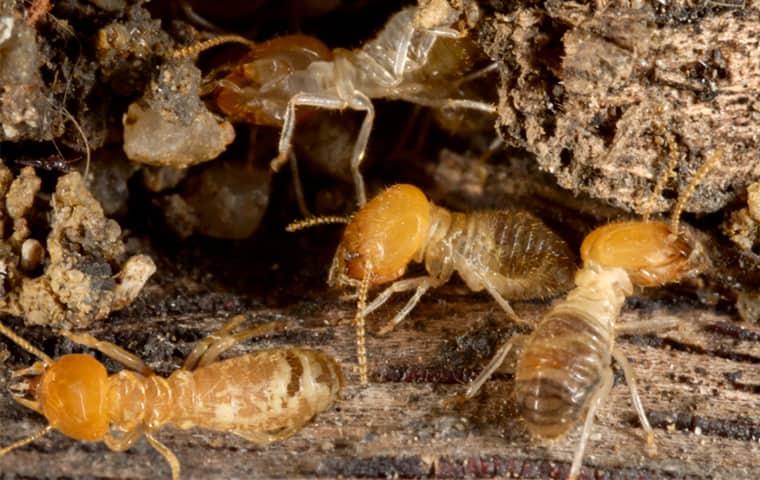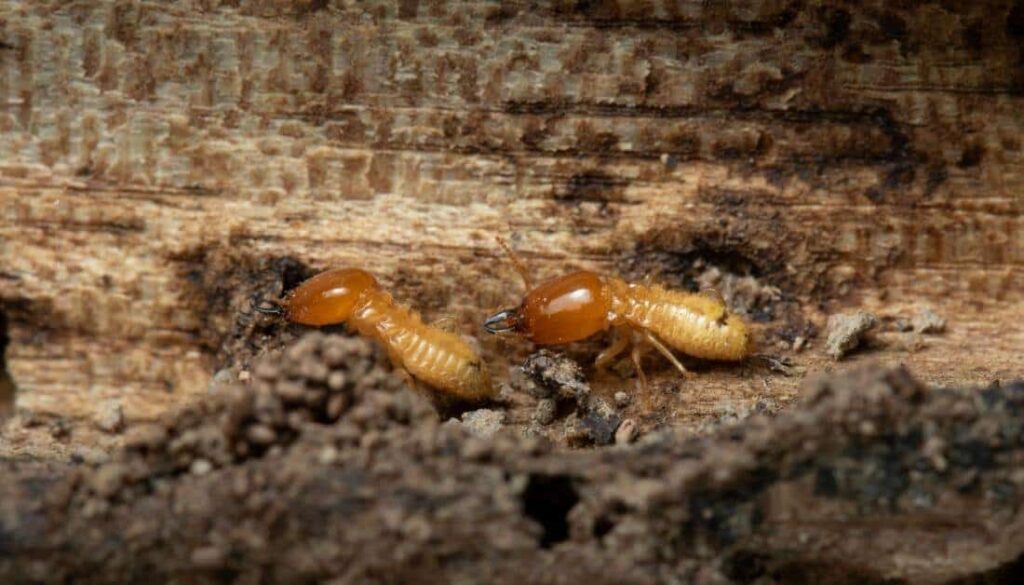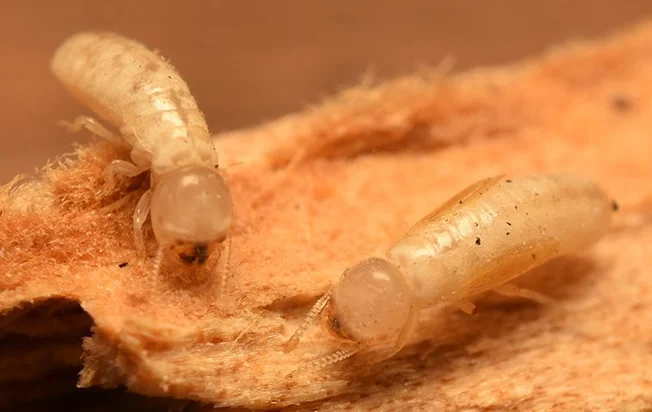No, termites are virtually silent when they chew on wood. Their feeding sounds are typically too faint for human ears to detect without specialized equipment.
Here’s why you can’t hear the termite’s chewing:
- Termite mandibles are tiny and generate minimal noise.
- Chewing occurs deep within the wood, muffling sounds.
- The sound frequencies they produce are often too low for human hearing.
- The wood itself absorbs and dampens sound.
- Termites typically feed in concealed, enclosed spaces.
- Their activities are usually slow and subtle.
- Human ears are not attuned to detect such faint noises.
Unveiling the Secrets: Can You Hear Termites Chewing?

Termites are renowned for their secretive and silent nature, but can you really hear them chewing? Here, we’ll dispel common misconceptions, explain how termites feed, and explain why their activities are inaudible to humans.
A. Dispelling Misconceptions About Hearing Termites Chew
Misconception: Some people believe they can hear termites chewing on wood. Contrary to popular belief, termites are virtually silent when they feed on wood, and human ears cannot detect their chewing sounds.
B. How Termites Actually Feed and Digest Wood Materials
Termites have specialized adaptations for feeding:
Mandibles: Termites use mandibles to bite off tiny pieces of wood.
Saliva: They secrete enzymes and saliva containing microorganisms that help break down cellulose in wood.
Digestive System: Termites have a unique digestive system that allows them to extract nutrients from wood through microbial fermentation.
C. the Sounds Termites Make and Why They Are Not Audible to Humans
Termites do produce sounds, but they are typically not detectable by the human ear due to their frequency and size:
Head-Banging Signals (Soldier Termites):
- Termites communicate using vibrations; one well-known behavior is head-banging by soldier termites.
- When soldiers detect a potential threat or disturbance, they can strike their heads against the tunnel walls to create vibrations.
- These vibrations serve as warning signals to alert other colony members, particularly workers, about potential danger.
- The frequencies of these vibrations are usually very high, often beyond the range of human hearing, typically from 20 Hz to 20,000 Hz.
Worker Activity:
- Workers are the termites primarily responsible for feeding and tunneling activities, and they can generate vibrations as they chew and move through wood.
- While these vibrations do produce sound, they are typically too faint and high-pitched for human ears to detect.
- The size and frequency of the vibrations are simply not within the range of sounds that humans can perceive.
Sound Attenuation in Wood:
- Wood is an excellent insulator of sound, which further contributes to the inaudibility of termite activity.
- Sounds generated by termites within the wood are dampened and absorbed by the surrounding material, making them even less likely to reach the surface and be heard.
In summary, termites do produce sounds as part of their communication and feeding activities, but the frequencies and amplitudes of these sounds are typically beyond the range of human hearing.
Additionally, the insulating properties of wood further obscure any sounds produced, rendering them virtually inaudible to us.
Therefore, the myth that one can hear termites chewing on wood is dispelled, as their activities remain largely silent to the human ear.
The Anatomy and Lifestyle of Termites
Termites are fascinating creatures with a secretive lifestyle. In this blog post, we’ll explore different termite species, their feeding habits, roles within a colony, and the surprising silence of their destructive activities.
A. Description of Different Termite Species
Termites belong to various species, but broadly, they can be categorized into three main types:
Subterranean Termites: These termites live underground and are responsible for most structural damage.
Drywood Termites: They infest dry wood structures and furniture.
Dampwood Termites thrive in moist wood, often found in decaying trees or logs.
B. Their Feeding Habits and Behavior
Termites are primarily cellulose eaters, which means they feed on materials containing cellulose, like wood, plants, and paper. They have specialized microorganisms in their digestive system that help break down cellulose into nutrients they can digest.
C. Roles Within a Termite Colony
Termite colonies are highly organized and consist of different castes, each with specific roles:
- Worker Termites: These termites are responsible for foraging, feeding, and maintaining the nest.
- Soldier Termites: They protect the colony from predators, often ants.
- Queen Termite: The queen lays eggs and is the reproductive center of the colony.
- King Termite: The king’s primary role is to mate with the queen.
D. Silent Nature of Their Destructive Activities
One of the most intriguing aspects of termites is their silence. While they cause significant structural damage, their chewing is virtually soundless.
Termites have evolved to be incredibly discreet when feeding on wood, making it challenging to detect an infestation until the damage becomes extensive.
Conclusion: Termites are remarkable creatures with unique adaptations for their cellulose-rich diet and silent yet destructive behavior.
Understanding their anatomy, lifestyle, and roles within a colony can help homeowners take preventive measures to protect their homes from these silent invaders.
Where Do Termites Hide in Your Home?

Termites are silent invaders that can wreak havoc on your home without you even knowing. Here, I explored where termites hide, signs to watch out for, and the factors that contribute to termite infestations.
A. Common Areas Where Termites Can Be Found
Termites have a knack for hiding in plain sight, often in:
Wooden Structures: They nest in wooden components of your home, such as beams, joists, and even furniture.
Soil and Mud Tubes: Subterranean termites create mud tubes on surfaces to access food sources and maintain their humidity levels.
Tree Stumps and Dead Trees: Termites thrive in decaying wood, making old tree stumps and logs ideal hiding spots.
Mulch and Yard Debris: Wood mulch and yard waste can provide a bridge for termites to access your home.
B. Signs to Look for When Suspecting a Termite Infestation
Detecting termites can be challenging, but these signs can help:
Hollow-Sounding Wood: Tap on suspected infested wood; hollow-sounding wood can indicate termite damage.
Mud Tubes: Look for pencil-sized mud tubes on walls or foundations, a telltale sign of subterranean termites.
Discarded Wings: Flying termites shed their wings, leaving them behind near windows or light sources.
Tiny Holes or Frass: Small exit holes or tiny piles of termite droppings (frass) may be visible.
C. Factors Contributing to Termite Infestations
Several factors contribute to termite infestations:
Moisture: Termites need moisture to thrive, so damp or humid conditions attract them.
Wooden Structures: Homes with extensive wooden components offer ample food sources.
Lack of Maintenance: Neglected maintenance, such as wood rot or leaking pipes, can create attractive termite habitats.
Proximity to Soil: Homes with direct wood-to-soil contact are at higher risk.
Eventually, Termites are master hiders, making it crucial to remain vigilant for signs of infestation.
FAQs
Can you hear termites chewing?
No, termites are typically very quiet while they feed on wood. Their chewing sounds are usually too faint for humans to hear.
Do termites make any noise at all?
Yes, termites can produce faint clicking or rustling sounds when disturbed or threatened, but these sounds are not related to their chewing or feeding activities on wood.
Can I detect termite activity by listening to sounds on my walls?
No, you cannot reliably detect termite activity by listening for sounds in your walls, as termites are usually very quiet while feeding on wood.
Are there specific tools to detect termite sounds?
Yes, pest control professionals use specialized acoustic devices to detect and amplify the faint sounds made by termites while feeding within wood structures.
What sounds can termites make when disturbed?
When disturbed, termites can emit warning sounds by tapping their heads on the wood surfaces, which signals danger to the colony.
Are termite noises a sign of an infestation?
Yes, while termite sounds can indicate their presence, other evidence, like damaged wood or discarded wings, is usually more reliable for confirming an infestation.
Can I use a stethoscope or a similar device to listen for termites?
While it’s theoretically possible, detecting termites with a stethoscope is extremely difficult due to the faintness of their sounds and the interference of building materials.
Are termites sound harmful to humans?
No, termite sounds are not harmful to humans; they are simply a part of termite behavior and do not threaten human health.
Conclusion
While it may be difficult to hear termites chewing, there are a few reasons for this.
Firstly, the sound produced by termites is generally very faint and may not be audible to the human ear. Additionally, termites tend to chew on wood from the inside out, creating tunnels and galleries that muffle the sound.
Furthermore, termites are most active within the walls and structures of buildings, making it challenging for sound to travel through solid materials.
Notably, the lack of audible chewing does not diminish the potential damage that termites can cause to structures, making regular inspections and preventive measures crucial in termite control efforts.

